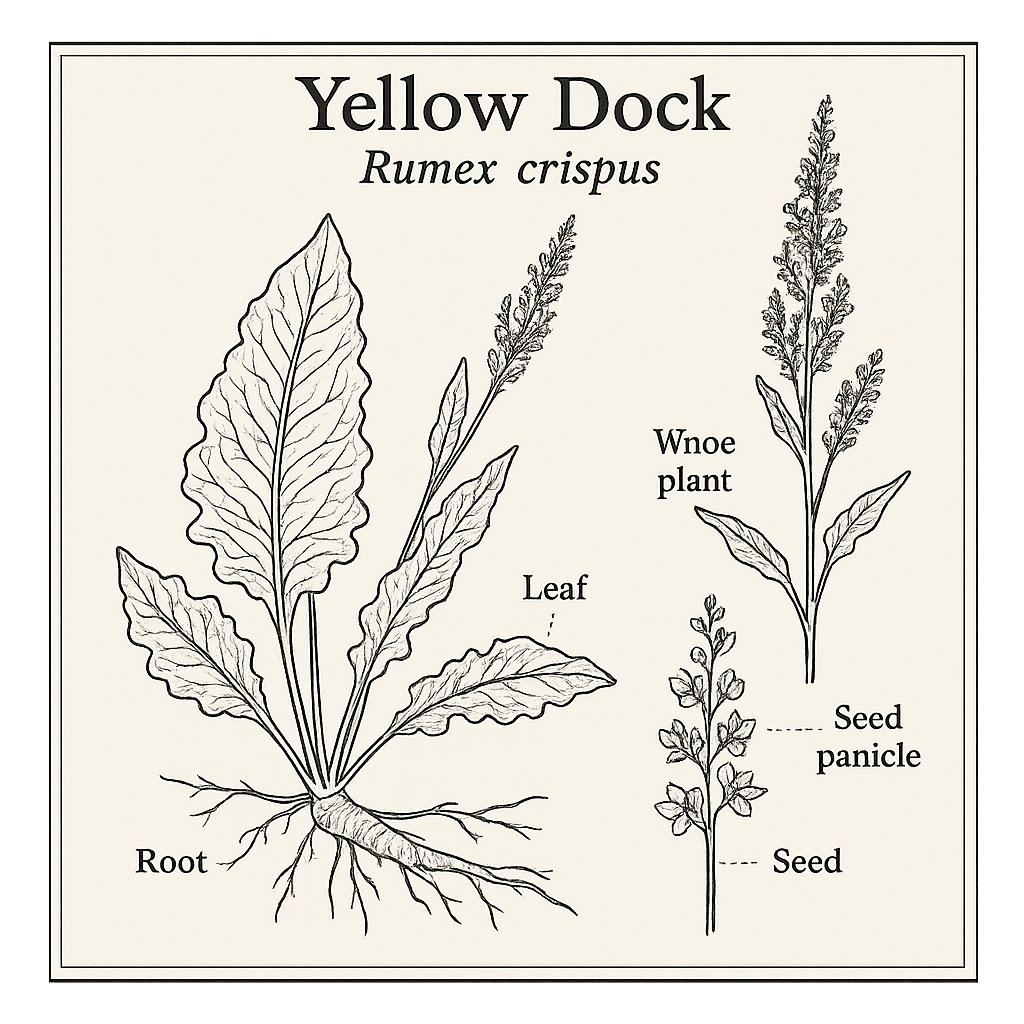Yellow Dock
Rumex crispus L. — Materia Medica

Snapshot
Root contains anthraquinone derivatives (emodin, chrysophanol, physcion) supporting a mild stimulant-laxative action in short-term use. Broader alterative/hepatic/skin actions are traditional and preclinical; modern human trials are limited.Yellow dock (Rumex crispus)—often called yellow dock, curly dock, or curled dock—is a perennial plant in the buckwheat family (Polygonaceae). The yellow-gold inner root and the leaf’s wavy margins help distinguish it among Rumex species. In Western herbalism it is described as a classic bitter herb with gentle laxative effects and general digestive support. Human evidence is limited; most information comes from tradition and constituent chemistry. In the landscape it commonly appears along field edges and disturbed soil.
Constituents & traditional rationale
Roots contain chemicals called anthraquinones (e.g., emodin, chrysophanol, physcion)—the same class as an anthranoid laxative—and this aligns with a mild stimulant laxative profile at an appropriate dose. Tannins contribute gentle astringency. Leaves contain oxalic acid/oxalates; cooking reduces sharpness (raw curly dock leaves are not preferred).
Preparations (educational)
- Herbal teas / decoction (root): 2–4 g dried root per ~500 mL; simmer 10–15 minutes; up to 1–2 cups per day.
- Tincture (root): typical maker ratio 1:5 in 40–60% alcohol; the appropriate dose varies—start low and assess.
- Powder/capsule: small amounts with water; follow relevant directions on the product.
- Pairs well with: dandelion (bitters) and burdock (alterative).
Notes are educational and not a substitute for professional advice.
Safety & cautions (educational)
Use modest amounts when taking yellow dock. Because of its mild stimulant laxative nature, higher or prolonged use may cause cramping or loose stools; separate from medicines by several hours.
- Potassium levels: anthraquinone herbs may decrease potassium levels. Use caution with diuretic drugs (water pills), which also affect potassium levels.
- Kidneys: people with kidney stones or kidney disease should seek guidance; oxalates can form crystals.
- Populations: avoid during pregnancy, breast feeding/breast milk contexts, and in children.
- Bleeding/clotting: consult a professional if you have blood clotting problems or a clotting disorder.
- Allergy & labs: seasonal weeds/pollens may irritate sensitive noses; disclose supplements before clinical laboratory tests.
- Leaves: avoid uncooked yellow dock; cook leaves to reduce oxalates.
Interactions with diuretics
If you use diuretic drugs (water pills), speak with a clinician. Both may influence fluid balance and potassium levels; combining can increase risk. Follow relevant directions from your provider.
Educational content only; not medical advice.
Identification & Harvest
Taproot with yellow interior; wavy-margined leaves in basal rosette. Common along fields/roadsides; often naturalized. Harvest roots late fall or early spring; slice and dry promptly.Preparations
- decoction
- tincture
- powder
- syrup
- poultice
Safety
Short-term use only for laxative action; avoid in pregnancy, lactation, children <12, and in intestinal obstruction/ileus. Caution with diuretics/cardiac glycosides due to hypokalemia risk. Leaves are high in oxalates—cook if using as food.Related Research
No studies yet.
